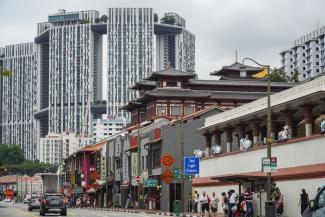Relevant reading
Singapore’s clever approach to public housing

Singapore’s method of providing public housing is unique. Of the city state’s 5.8 million residents, 82 % live in homes built by the state-run Housing Development Board (HDB). The rents of the most affordable of these flats lie far below the market price. On the other hand, many of the apartments are eventually sold, so the share of homeownership is very high in this densely populated south-east Asian nation.
Singapore is a global financial and trading centre. Market competition is generally welcome. Nevertheless, the state intervenes with regulations in key areas with an eye to promoting social equity (see conversation with Anna-Katharina Hornidge in D+C/E+Z e-Paper 2020/10, Focus section). Indeed, the cost of living tends to be high in what is often considered to be a “millionaires’ oasis”. Housing costs matter very much.
UN-Habitat, the UN’s housing and settlement programme, has devoted the latest issue of its “Housing Practice Series” to Singapore. The series assesses public-housing programmes from around the world. It serves to inform developing countries about how to create urban spaces, prevent the emergence of slums and improve people’s living conditions. The aim is to provide adequate, affordable and sustainable housing to everyone. That is the UN’s 11th Sustainable Development Goal (SDG).
In response to fast population growth, Singapore began building public housing in the early 1960s. The HDB has since built more than a million housing units. It has also met other urban planning goals in the process, including the removal of slums, the redevelopment of the city centre and expanding industry. Urban planning helped to overcome various social and political challenges arising from Singapore’s ethnically diverse population.
According to the UN report, the approach was successful for several reasons. People were given much more than an affordable roof over their heads. The authorities created urban environments in which residents could live, work, learn and spend their free time. Housing complexes thus became the centres of social infrastructures. Input from the people concerned and close cooperation with all relevant state agencies were essential. The authors point out that the people strongly identify with the environment they live in. It helps, of course, that – in contrast to many other countries – public housing in Singapore is not synonymous with poor quality and a lower class population.
Two segments
In the 1980s, the state temporarily halted the construction of new public housing and declared that it wanted as many people as possible to own their homes. As a result, there were then two categories of publicly built housing. While owner-occupied flats were new and large, rental flats were older and smaller. The consequence was that demand for something in between social housing and homeownership was no longer being met. In the meantime, however, smaller flats have also become available for purchase.
Since the 1990s, the focus has been on renovating aging buildings and improving their local environments. Many residents are now elderly, but live in the same flats. Modernisation programmes must take their changed needs into account. At the moment, the HDB is primarily focussing on creating attractive housing for the next generation of residents.
According to UN-Habitat, Singapore shows that it is possible to reverse the general trend towards less and less public housing and that, now as in the past, housing promotion can contribute to social stability in economically uncertain times.
Link
UN-Habitat, 2020: Housing Practice Series – Singapore.
https://unhabitat.org/housing-practice-series-singapore








